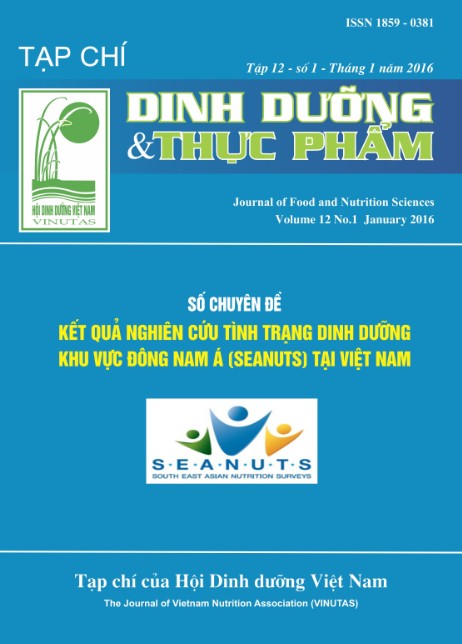PREVALENCE OF ANEMIA AMONG 6 MONTHS TO 11 YEARS OLD CHILDREN IN 2012
Main Article Content
Abstract
A cross-sectional study has been conducted in 194 children aged 0.5- 5 and 388 aged 6-11 to investigate the prevalence of anemia among primary school children in 6 provinces across Vietnam. Hemocue method was applied to measure the amount of hemoglobin in children aged 0.5 to 5.9 and auto counter was applied in children aged 6 to 11. Results: The prevalence of anemia in children under 6 years of age was 23%, 25% in rural areas and 20% in urban areas. The prevalence of anemia varied by age groups. The youngest children (6 – 24 months) sufferred the highest prevalence of anemia compared to other groups (25.9% in urban and 54.3% in rural). The prevalence of anemia in school children (6-11 years) was 11.8% (11.3% in urban and 13.7% in rural), which was classified as mild level of public health significant problem. The percentage
of children with depleted iron reserves (ferritin <15ug / L) was 6%. The prevalence of children with low iron stores (ferritin <30ug / L) was 28.8%. The rate of iron deficiency anemia (Hb <11.5 g / dl and ferritin <30ug / L) was 23.9%. There was a positive association between Hb concentration and MCV in school-aged children. Conclusion: Anemia in children is a public health significant problem. The prevention of anemia should be promoted by appropriate interventions to lower the prevalence of anemia among
children in the community in the next coming years.
Keywords
Anemia, iron deficiency, school children
Article Details
References
2. World Bank. School age children: Their Nutrition and Health. SCN News No 25. 2002.
3. Wieringa FT, Dijkhuizen MA, West CE, Northrop-Clewes CA, Muhilal. Estimation of the effect of the acute phase response on indicators of micronutrient status in Indonesian infants. J Nutr. 2002;132:3061–6.
4. WHO/UNICEF/UNU, 2001. Iron deficiency anemia: assessment, prevention, and control. Geneva, World Health Organization, (WHO/NHD/01.3).
5. NIN/MOH/UNICEF. General Nutrition Survey 2009-2010. Medical Publishing House, Hanoi, 2010.
6. Nguyen, P.H., et al., A situational review of infant and young child feeding practices and interventions in Viet Nam. Asia Pac J Clin Nutr, 2011. 20(3): p. 359-74.
7. Nguyễn Xuân Ninh và CS. Đánh giá tình trạng thiếu vi chất dinh dưỡng tại 6 tỉnh miền núi phía Bắc, miền Trung và tây Nguyên, năm 2009. Báo cáo kết quả đề tài 2010.
8. Đỗ Kim Liên, Bùi Thị Nhung, Nguyễn Văn Khang, Nguyễn Đỗ Vân Anh, Lê Thị Hợp, Nguyễn Công Khẩn. Hiệu quả của uống sữa và sữa giàu đa vi chất lên tình trạng dinh dưỡng và vi chất dinh dưỡng của học sinh tiểu học. Hội thảo KH: Cải thiện Dinh dưỡng và gia tăng tăng trưởng ở người Việt Nam, 2006, tr 85-100.
9. Lê Thị Hương. Tình trạng dinh dưỡng và một số yếu tố liên quan của trẻ em hai trường tiểu học Hà Nội, Luận văn Thạc sỹ dinh dưỡng cộng đồng, trường Đại học Y Hà Nội. 1999


